Hiking in Patagonia
In 2018 I had the wonderful opportunity to hike in Patagonia with a group of friends from my hiking club. For me, two new countries that I am so grateful that I was able to see – Argentina and Chile.
We left mid-November when the weather at home was leaning towards shorter, darker, colder, and arrived to a warm, colourful spring in Buenos Aires. The jacaranda trees, which don’t grow in my southern Ontario climate, were so delightful to see, with mature trees in full bloom everywhere it seemed.
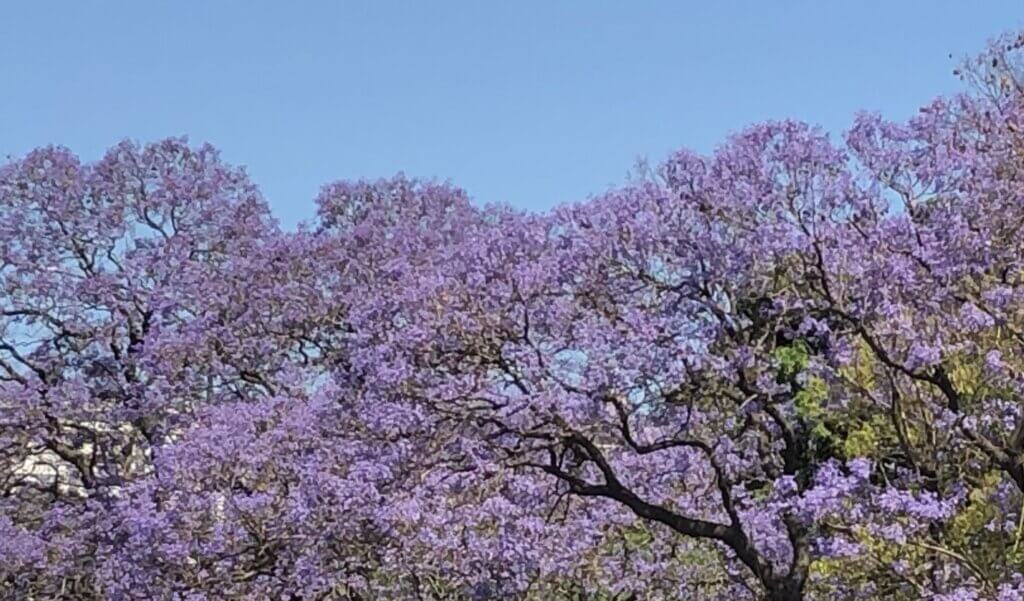
The Bottom of the World
Our hiking adventure started further south – we still had a 3 ½ hour flight to the bottom of the continent, Ushuaia, from where you can send special postcards from “The End of the World Post Office”. Ushuaia is the gateway to Antarctica and home to the Tierra del Fuego National Park, where we started our outdoor hiking adventure. Our local guide led us on a series of short hikes in the park, explaining the history and telling some interesting stories. The one that resonated most with me was what he told us about beavers, 20 of which were brought in from Canada in 1946 with the hopes of establishing a fur trade. Unfortunately, since the beaver had no natural predator in South America, they grew and multiplied – resulting in thousands of gigantic beavers that now pose an ongoing threat to the natural landscape. I guess they didn’t do a risk assessment….
We were also introduced to the bearded lenga trees, which grow in abundance in this part of the world, but not really in other colder, snowy climates.
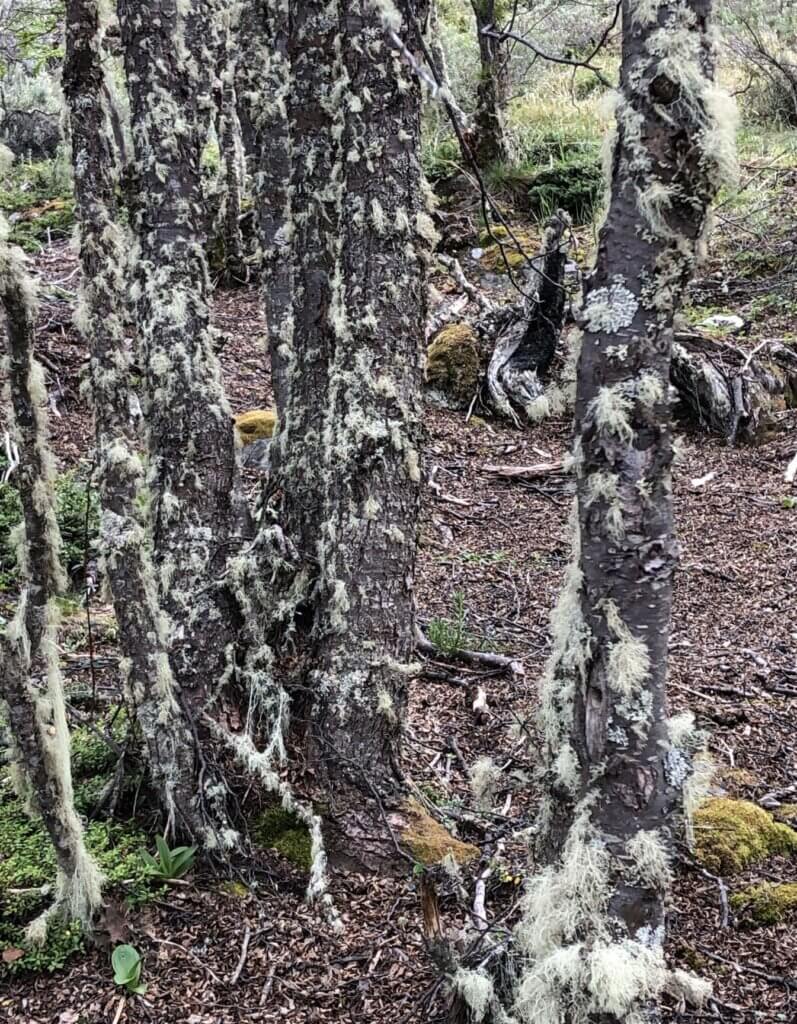
Legendary Patagonia Winds
Our next hiking day was a lesson in the “variable” Patagonia weather conditions that we had been warned about. Expecting rain, we woke up to a beautiful sunny day. As we awaited our bus taking us to the trail head, it was pouring rain. Then, it started to snow. However by the time we reached the trail head it was beautiful sunshine again! This is all within an hour or so. Today’s destination was Ushuaia Summit, aka Del Medio Mountain, which starts among the lenga trees at a fairly low 200M (650 ft) of elevation. We hiked up to the tree line, where it was cooler and cloudier, and as we reached the summit we were in a raging blizzard. I was so grateful that we were with local guides, as they assured us this was all perfectly normal. At the summit, we also experienced the legendary Patagonia winds. At one point I bent down to pick up someone’s dropped glove, and I couldn’t get up! The winds come simultaneously from all directions and would not allow me to move. We had been warned, but until you are motionless in the grip of a wind gust it is really hard to imagine how it feels. During the less windy interludes, we made our way back down, arriving once again to brilliant sunshine – t-shirts only. What an experience – 4 seasons in a 15K (9M) trek and we were back mid-afternoon. Enough time to explore some local trails close to the hotel and enjoy the long day, seeing the sunset around 10 pm.
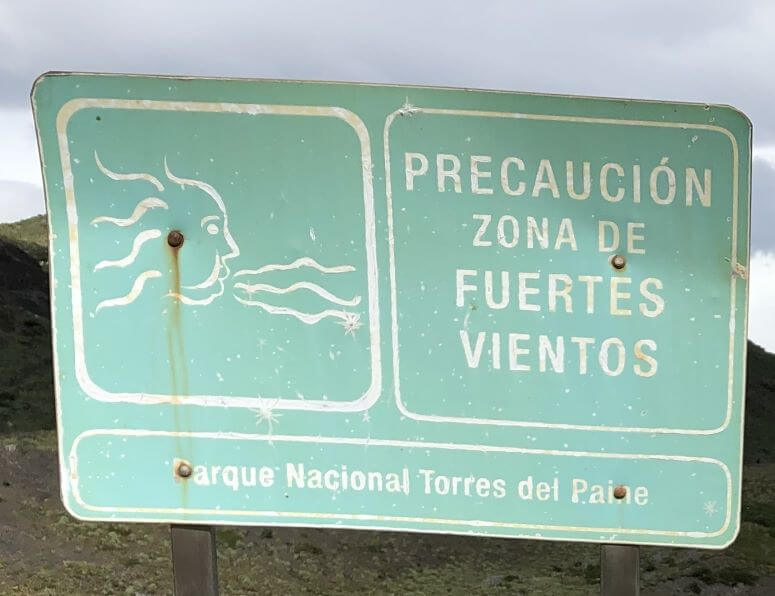

The following day’s hike was to Argentina’s Martial Glacier, a 20,000-year-old glacier offering panoramic views of the bottom of the world. Total ascent today was only 400M (1,300 ft) and 8KMs (5M), but it took longer than yesterday – today was steeper. Still, lots of smiling faces at the top!
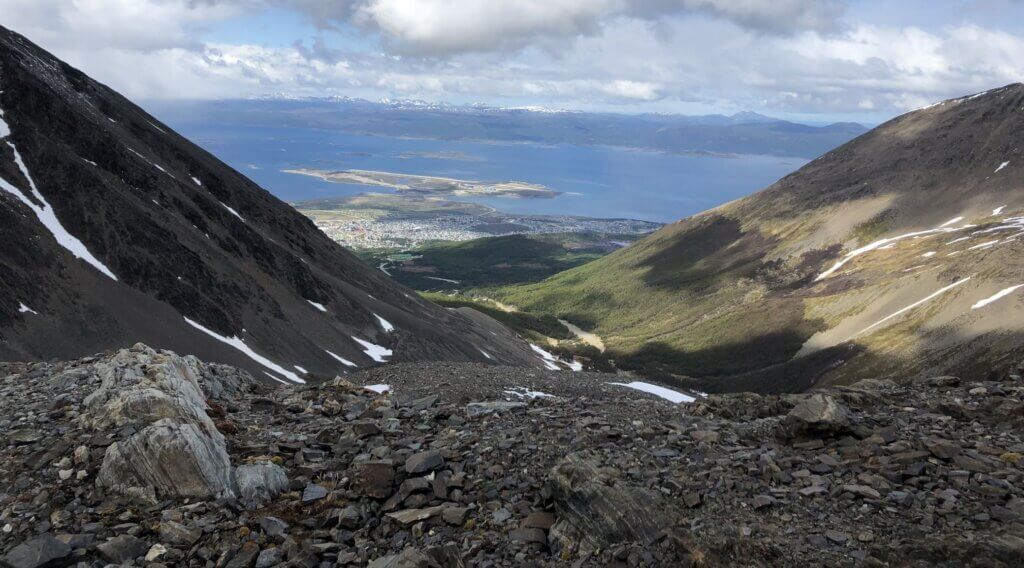
We later boarded a plan to take us to El Calafate, and then a bus to El Chaltén, with a goal of seeing Mount Fitz Roy. Climbing Fitz Roy is best left to mountaineers, we hikers were happy to be in the area, described as the National Capital of Trekking in Argentina, with a planned hike to Mirador Capri. On a sunny day, we would have been rewarded with panoramic views of the Rio de las Vueltas and the impressive Mount Fitz Roy, a famous destination and recognizable landscape. Unfortunately – it was not a sunny day and our views were completely obstructed by clouds and a very un-variable rainy day. We completed our Laguna Capri trek which did have some really nice trails and viewpoints, regularly experiencing more of the famous Patagonia winds along the way. The lagoon is located in a beautiful, forested area with lots of varied local fauna.
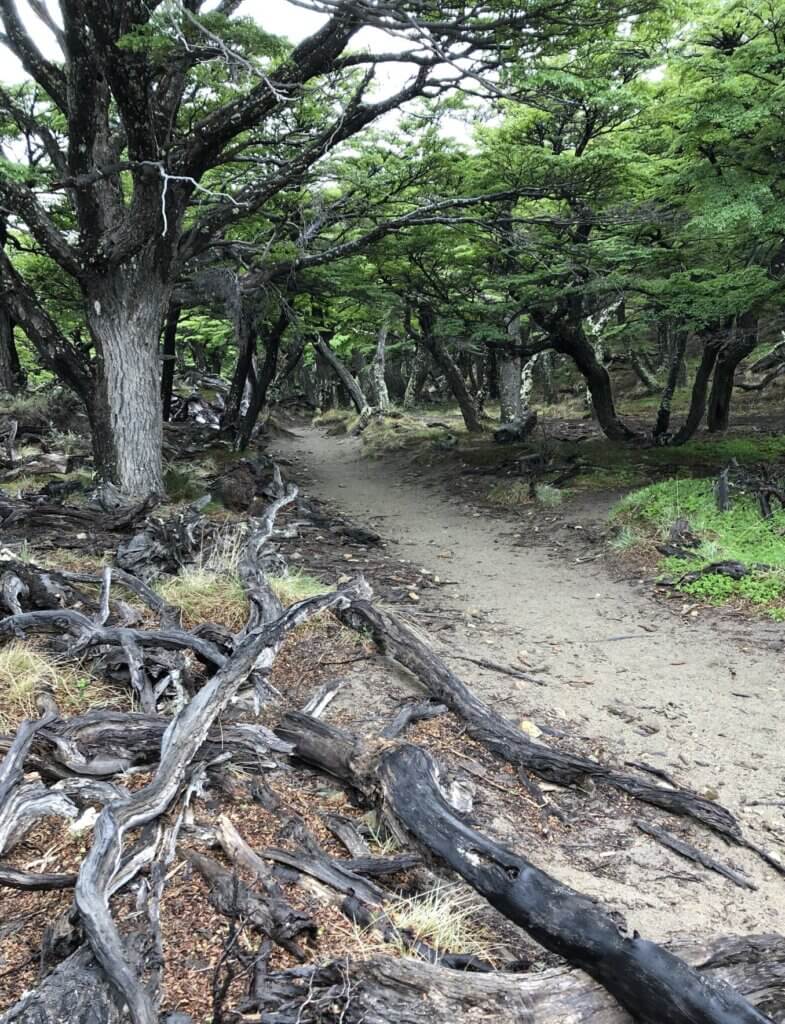
The following day was less cloudy and we were at least able to take pictures of what we missed – but we had to move on. Back to El Calafate, our next hike was the Perito Moreno Glacier in the Glacier National Park.
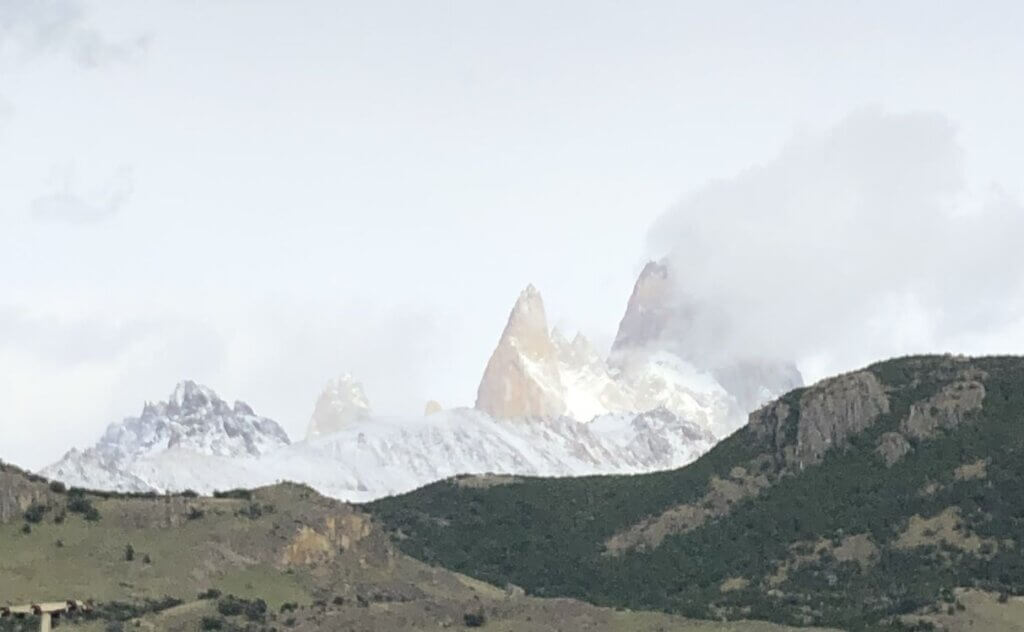
Hiking on a Glacier
I am so grateful that I had the opportunity to visit glaciers before they are gone. Southern Patagonia’s ice field includes over 200 glaciers, with at least 47 of them in Los Glaciares National Park, a UNESCO World Heritage property. Our guide told us that glaciers in the area are receding by 500M per year (1640ft).
The Perito Morino glacier is famous because it is a live glacier, accumulating mass at a rate similar to that of its loss. Walking on the glacier was certainly a highlight for me. If you want to trek on the glacier, you must do it with approved guides, which is a good thing as there is no wayfinding on the glacier. There are lots of ups and downs, no clear pathways, and steep drops into water. It feels like you are walking on ice cubes. As we walked we heard loud booms as chunks of the glacier broke off. When the sun came out it was so bright you were blinded and couldn’t see anything in the camera lens. The ice is very sharp, which I learned the hard way as I cut my hand in a crevice when I reached in to get a drink of water. Wow – drinking water from something that is millions of years old. It is undoubtedly one of the more interesting hikes I have ever done.
What strikes you most about the glacier is its size. This is one of my favourite photos, showing the scale of people to glacier, and glacier to mountains in the background.
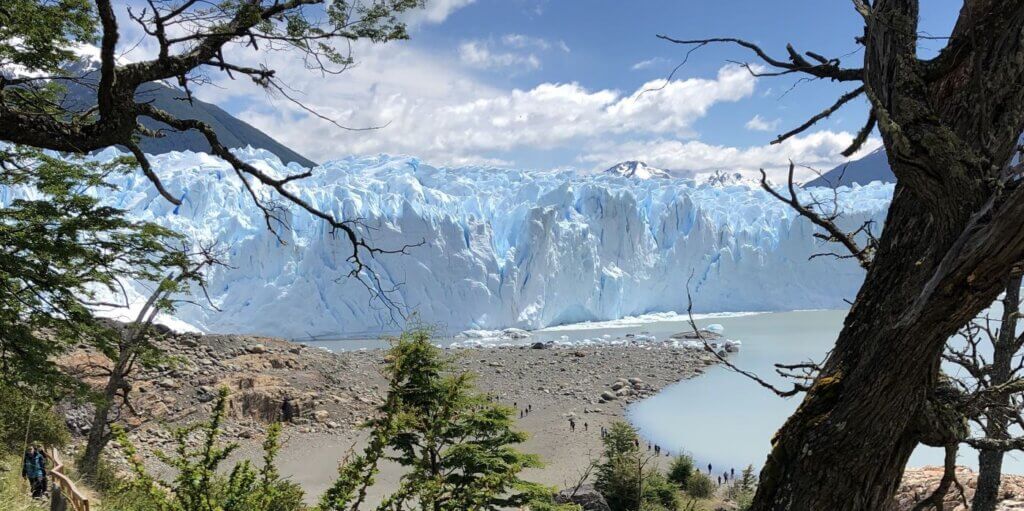
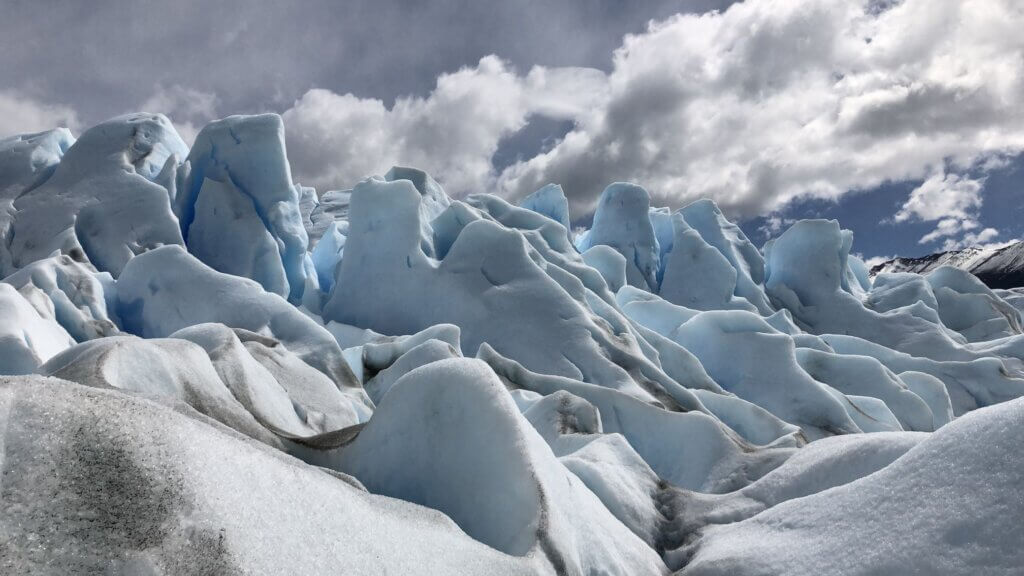
A stop at the Glaciarium Patagonian Ice Museum in El Calafate was a wonderful complement to visiting the glacier, offering scientific and technological information in a visual way that made you think deeply about global warming and the impacts to the natural environment.
On to Chile
Completing the Argentinian leg of our trip, we were now headed to the Torres del Paine National Park in Chile, known for soaring mountains, golden grasslands and unique wildlife such as llama-like guanacos and condors, the largest flying birds in South America. We were advised that a big treat would be to see a puma.
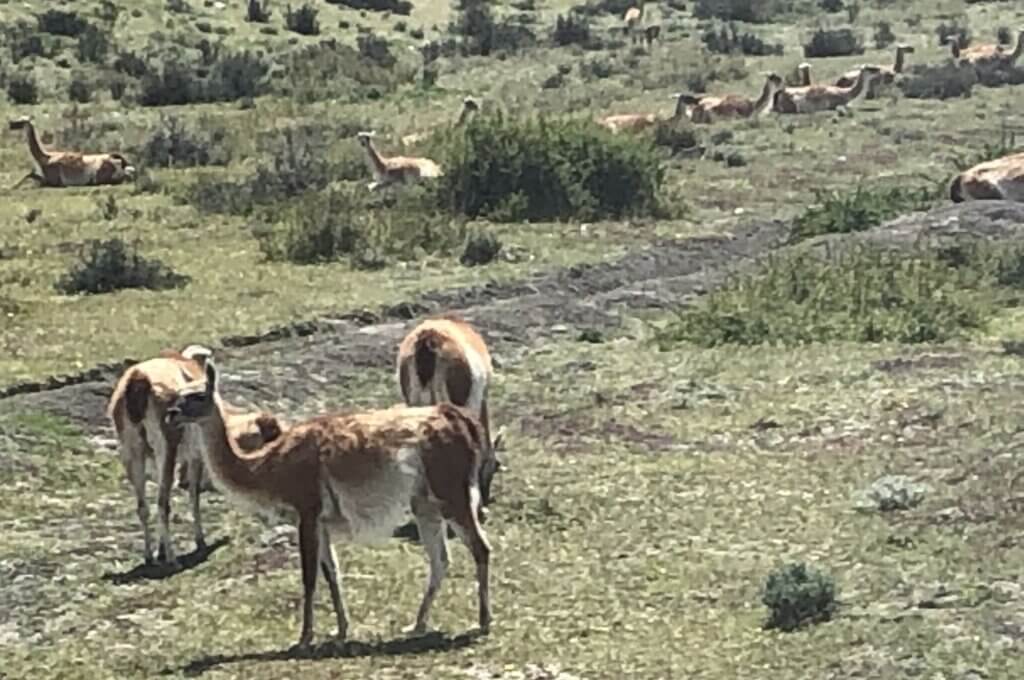
We did one day of bus touring enabling us to see more of the park. We saw a lot that day, including include Puente Negro (Black Bridge), Nordenskjöld Lookout, Sarmiento Lookout, Lake Pehoé and Salto Grande waterfall. We also had a lake cruise to Grey Glacier. For sure, we would not have covered that amount of territory by foot, however we barely had time to do more than take pictures. It is breathtaking no matter where you look. We had a short 6KM hike to some caves said to have drawings that are 4000-6000 years old (the Pinturas Rupestre). Fascinating to see, but tempered by the comment from the guide that some (knowledgeable) people think they are fake.
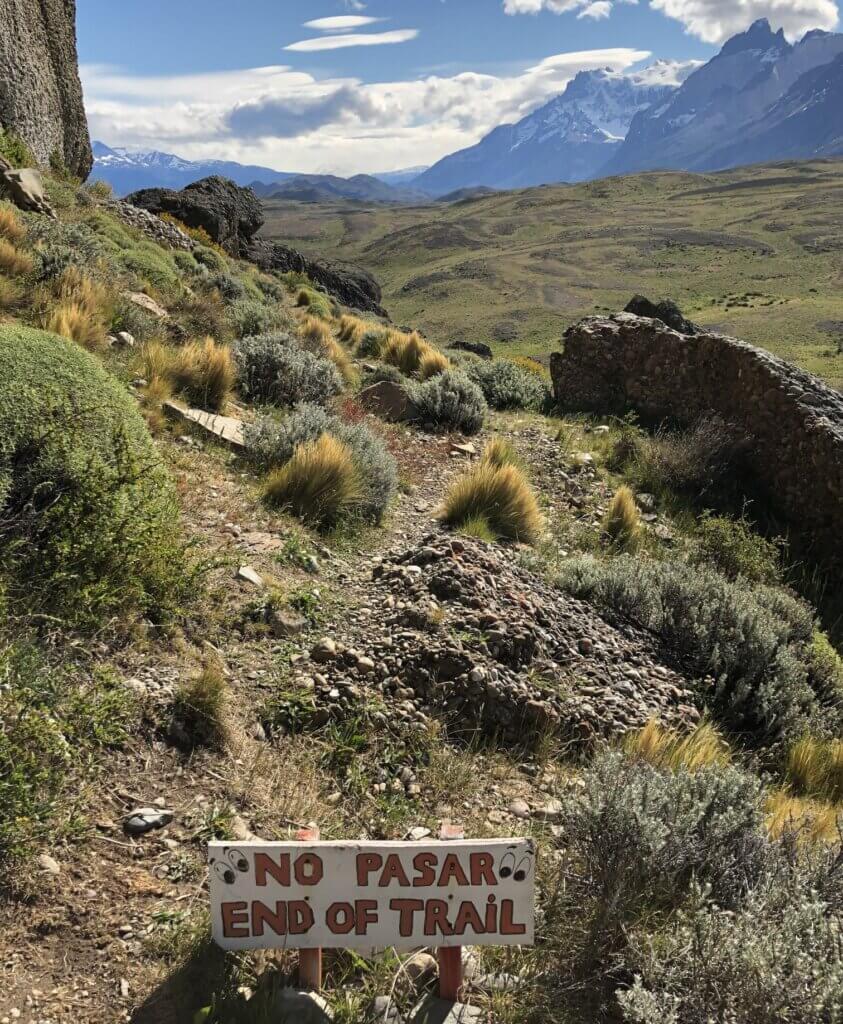
The next day we had a choice between hiking to one of the National’s Park’s most striking viewpoints, or a trek that included the Laguna Verde (Green Lagoon), the Laguna Honda (Deep Lagoon) and climbing to a summit with a 360° view of the Paine Massif in the north, and Lago Toro (the largest lake in the region).
I wanted to do both, but selected the first hike going to the top of Cerro Paine (Paine hill), along a scenic portion of the Ascencio Valley. Some of our group were riding horses up, but I don’t ride. No regrets on choice – the view was truly astounding. We had a panoramic view of the Torres (the three famous granite towers), the Paine River Valley and Laguna Azul, and lakes Nordenskjöld and Sarmiento. A wonderful mix of granite peaks, glaciers, lakes, forest and Patagonian pampas all at once! And, lots of stories in the evening listening to the tales of the riders. What a fantastic day for everyone.
On our last hike, we explored the Laguna Verde and the Ascencio Valley. This part of the park was busier as there are a lot of people who come in for the day only, choosing this location because it is not as challenging. I guess they were on a tight schedule as many seemed to be almost running to get to the end, perhaps without really appreciating the journey. I was so grateful to be travelling with the group from my club – together we experienced some incredible wonders of Patagonia with a sense of shared awe and accomplishment.
PUMA!!
The next day we were leaving, and it was the most beautiful day – absolutely no wind. It was like Torres del Paine was bidding us “adios” and showing off her beauty.
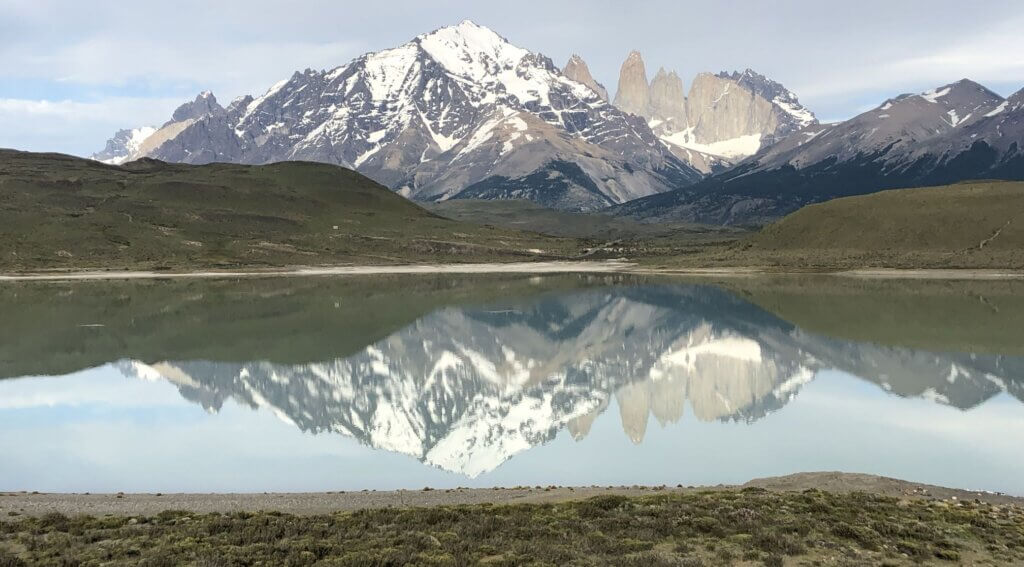
And to top it off, on our way to the airport we saw a PUMA! Wow – our trip was complete. My fondest memory of this major event was of our local bus driver, who was as excited as we all were. He yelled “puma” loudest and immediately backed up the bus so that we could all see. He wanted pictures too! Such an amazing, shared experience, and a perfect story-book ending to an outstanding trip.

Where else can my feet take me?
Please contact me if you are interested in discovering wonderful places with a new travel community!
3 highlights:
- Our amazing Chilean guides who trekked with us and were so sharing with stories about themselves and their country
- Walking on a glacier, and thinking about how old these ice crystals are, and how beautiful a glacier can be
- The new experience of being immoveable in the Patagonia wind
3 things for the next time:
- See more of the Patagonia region – it is huge and I learned that I have only seen a small part of it
- Do a tour that includes a visit with penguins near Ushuaia
- Travel from Argentina to Chile via the Andean Lakes – a one-day journey, done as a series of lake crossings, that is reportedly spectacular
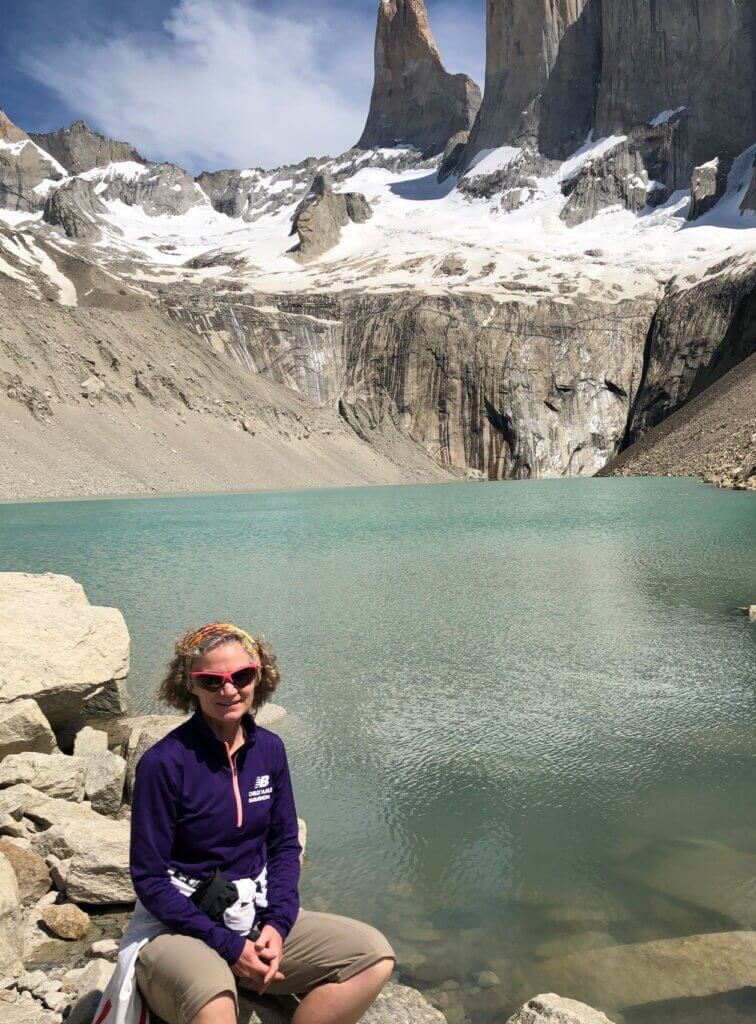
Recent Posts
Cycling Thailand
Cycling in Vietnam
Cycling in Holland
All Categories
Tags
Hiking in Patagonia
In 2018 I had the wonderful opportunity to hike in Patagonia with a group of friends from my hiking club. For me, two new countries that I am so grateful that I was able to see – Argentina and Chile.
We left mid-November when the weather at home was leaning towards shorter, darker, colder, and arrived to a warm, colourful spring in Buenos Aires. The jacaranda trees, which don’t grow in my southern Ontario climate, were so delightful to see, with mature trees in full bloom everywhere it seemed.

The Bottom of the World
Our hiking adventure started further south – we still had a 3 ½ hour flight to the bottom of the continent, Ushuaia, from where you can send special postcards from “The End of the World Post Office”. Ushuaia is the gateway to Antarctica and home to the Tierra del Fuego National Park, where we started our outdoor hiking adventure. Our local guide led us on a series of short hikes in the park, explaining the history and telling some interesting stories. The one that resonated most with me was what he told us about beavers, 20 of which were brought in from Canada in 1946 with the hopes of establishing a fur trade. Unfortunately, since the beaver had no natural predator in South America, they grew and multiplied – resulting in thousands of gigantic beavers that now pose an ongoing threat to the natural landscape. I guess they didn’t do a risk assessment….
We were also introduced to the bearded lenga trees, which grow in abundance in this part of the world, but not really in other colder, snowy climates.

Legendary Patagonia Winds
Our next hiking day was a lesson in the “variable” Patagonia weather conditions that we had been warned about. Expecting rain, we woke up to a beautiful sunny day. As we awaited our bus taking us to the trail head, it was pouring rain. Then, it started to snow. However by the time we reached the trail head it was beautiful sunshine again! This is all within an hour or so. Today’s destination was Ushuaia Summit, aka Del Medio Mountain, which starts among the lenga trees at a fairly low 200M (650 ft) of elevation. We hiked up to the tree line, where it was cooler and cloudier, and as we reached the summit we were in a raging blizzard. I was so grateful that we were with local guides, as they assured us this was all perfectly normal. At the summit, we also experienced the legendary Patagonia winds. At one point I bent down to pick up someone’s dropped glove, and I couldn’t get up! The winds come simultaneously from all directions and would not allow me to move. We had been warned, but until you are motionless in the grip of a wind gust it is really hard to imagine how it feels. During the less windy interludes, we made our way back down, arriving once again to brilliant sunshine – t-shirts only. What an experience – 4 seasons in a 15K (9M) trek and we were back mid-afternoon. Enough time to explore some local trails close to the hotel and enjoy the long day, seeing the sunset around 10 pm.


The following day’s hike was to Argentina’s Martial Glacier, a 20,000-year-old glacier offering panoramic views of the bottom of the world. Total ascent today was only 400M (1,300 ft) and 8KMs (5M), but it took longer than yesterday – today was steeper. Still, lots of smiling faces at the top!

We later boarded a plan to take us to El Calafate, and then a bus to El Chaltén, with a goal of seeing Mount Fitz Roy. Climbing Fitz Roy is best left to mountaineers, we hikers were happy to be in the area, described as the National Capital of Trekking in Argentina, with a planned hike to Mirador Capri. On a sunny day, we would have been rewarded with panoramic views of the Rio de las Vueltas and the impressive Mount Fitz Roy, a famous destination and recognizable landscape. Unfortunately – it was not a sunny day and our views were completely obstructed by clouds and a very un-variable rainy day. We completed our Laguna Capri trek which did have some really nice trails and viewpoints, regularly experiencing more of the famous Patagonia winds along the way. The lagoon is located in a beautiful, forested area with lots of varied local fauna.

The following day was less cloudy and we were at least able to take pictures of what we missed – but we had to move on. Back to El Calafate, our next hike was the Perito Moreno Glacier in the Glacier National Park.

Hiking on a Glacier
I am so grateful that I had the opportunity to visit glaciers before they are gone. Southern Patagonia’s ice field includes over 200 glaciers, with at least 47 of them in Los Glaciares National Park, a UNESCO World Heritage property. Our guide told us that glaciers in the area are receding by 500M per year (1640ft).
The Perito Morino glacier is famous because it is a live glacier, accumulating mass at a rate similar to that of its loss. Walking on the glacier was certainly a highlight for me. If you want to trek on the glacier, you must do it with approved guides, which is a good thing as there is no wayfinding on the glacier. There are lots of ups and downs, no clear pathways, and steep drops into water. It feels like you are walking on ice cubes. As we walked we heard loud booms as chunks of the glacier broke off. When the sun came out it was so bright you were blinded and couldn’t see anything in the camera lens. The ice is very sharp, which I learned the hard way as I cut my hand in a crevice when I reached in to get a drink of water. Wow – drinking water from something that is millions of years old. It is undoubtedly one of the more interesting hikes I have ever done.
What strikes you most about the glacier is its size. This is one of my favourite photos, showing the scale of people to glacier, and glacier to mountains in the background.


A stop at the Glaciarium Patagonian Ice Museum in El Calafate was a wonderful complement to visiting the glacier, offering scientific and technological information in a visual way that made you think deeply about global warming and the impacts to the natural environment.
On to Chile
Completing the Argentinian leg of our trip, we were now headed to the Torres del Paine National Park in Chile, known for soaring mountains, golden grasslands and unique wildlife such as llama-like guanacos and condors, the largest flying birds in South America. We were advised that a big treat would be to see a puma.

We did one day of bus touring enabling us to see more of the park. We saw a lot that day, including include Puente Negro (Black Bridge), Nordenskjöld Lookout, Sarmiento Lookout, Lake Pehoé and Salto Grande waterfall. We also had a lake cruise to Grey Glacier. For sure, we would not have covered that amount of territory by foot, however we barely had time to do more than take pictures. It is breathtaking no matter where you look. We had a short 6KM hike to some caves said to have drawings that are 4000-6000 years old (the Pinturas Rupestre). Fascinating to see, but tempered by the comment from the guide that some (knowledgeable) people think they are fake.

The next day we had a choice between hiking to one of the National’s Park’s most striking viewpoints, or a trek that included the Laguna Verde (Green Lagoon), the Laguna Honda (Deep Lagoon) and climbing to a summit with a 360° view of the Paine Massif in the north, and Lago Toro (the largest lake in the region).
I wanted to do both, but selected the first hike going to the top of Cerro Paine (Paine hill), along a scenic portion of the Ascencio Valley. Some of our group were riding horses up, but I don’t ride. No regrets on choice – the view was truly astounding. We had a panoramic view of the Torres (the three famous granite towers), the Paine River Valley and Laguna Azul, and lakes Nordenskjöld and Sarmiento. A wonderful mix of granite peaks, glaciers, lakes, forest and Patagonian pampas all at once! And, lots of stories in the evening listening to the tales of the riders. What a fantastic day for everyone.
On our last hike, we explored the Laguna Verde and the Ascencio Valley. This part of the park was busier as there are a lot of people who come in for the day only, choosing this location because it is not as challenging. I guess they were on a tight schedule as many seemed to be almost running to get to the end, perhaps without really appreciating the journey. I was so grateful to be travelling with the group from my club – together we experienced some incredible wonders of Patagonia with a sense of shared awe and accomplishment.
PUMA!!
The next day we were leaving, and it was the most beautiful day – absolutely no wind. It was like Torres del Paine was bidding us “adios” and showing off her beauty.

And to top it off, on our way to the airport we saw a PUMA! Wow – our trip was complete. My fondest memory of this major event was of our local bus driver, who was as excited as we all were. He yelled “puma” loudest and immediately backed up the bus so that we could all see. He wanted pictures too! Such an amazing, shared experience, and a perfect story-book ending to an outstanding trip.

Where else can my feet take me?
Please contact me if you are interested in discovering wonderful places with a new travel community!
3 highlights:
- Our amazing Chilean guides who trekked with us and were so sharing with stories about themselves and their country
- Walking on a glacier, and thinking about how old these ice crystals are, and how beautiful a glacier can be
- The new experience of being immoveable in the Patagonia wind
3 things for the next time:
- See more of the Patagonia region – it is huge and I learned that I have only seen a small part of it
- Do a tour that includes a visit with penguins near Ushuaia
- Travel from Argentina to Chile via the Andean Lakes – a one-day journey, done as a series of lake crossings, that is reportedly spectacular

